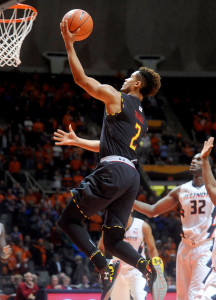COLLEGE PARK, Md. — Normally when a program watches four of its scholarship athletes transfer, it is both a sign of trouble brewing between the coach and the team and a harbinger of a rough year to come. Couple that with a move to a new conference, considered perhaps the most physical in the nation, and an initial glance at the Maryland men’s basketball team’s prospects in its first year in the Big 10 were bleak.
And yet, going into Saturday’s tilt with Michigan State at Xfinity Center (4 p.m. on CBS), The Terps are 16-2, tied atop the Big 10 at 4-1 in conference, and ranked 14th in the AP Poll and 11th in the USA Today Coaches Poll. They’ve gotten there thanks to a stellar class of freshmen and the steady growth of the players that remained after the exodus.
Freshman Melo Trimble has led the way as part of the Terps’ big three, joining junior forward Jake Layman and senior guard Dez Wells to account for more than 60 percent of Maryland’s scoring. But Trimble, a product of O’Connell High School, is joined by three other first-year players who have banked time in every game and have been key to the team’s production in Jared Nickens (6.5 points/1.4 rebounds), Dion Wiley (6.2/2.2) and Michal Cekovsky (3.3/2.9).
In all, eight players have logged time in every game, not including forward Evan Smotrycz and the aforementioned Wells. The Terps now run a rotation 10 deep, with nobody shorter than 6 foot 3 and six players 6 foot 7 or taller. That length provides a ton of matchup issues for opponents, helping Maryland fill passing lanes and play above the rim. But it also makes them more of a prototypical ACC team than a Big 10 one.
That made Maryland’s Big 10 opening win over Michigan State in East Lansing even more impressive. While the Spartans have shown cracks in the shield this year, Tom Izzo’s club is always strong on the glass. But the Terps out-rebounded Michigan State 52-36 (40-28 on the defensive end) in the 68-66, double-overtime victory.
Perhaps that’s why the perception, at least from the inside, has been that the club has been particularly strong defensively.
“Defense has carried us through those four games,” said Layman prior to the Terps’ 73-65 victory over Rutgers on Wednesday.
But while Maryland’s scoring output has dropped more than five points since entering conference play, their defense has actually allowed a point a game more. Both marks (67.4/62.6) are good for just fifth in the conference.
Ken Pomeroy’s rankings are equally skeptical of the Terps’ success thus far. He has Maryland 22nd overall, with the 17th-ranked adjusted offense, but just the 42nd-ranked adjusted defense. While these numbers can certainly improve, they are noteworthy when it comes to looking at Maryland’s chances as a viable national title contender.

No team has won a title in the years since Pomeroy has tracked these statistics (ironically, Maryland’s last championship year was in 2002) with worse than the 21st-ranked defense, when North Carolina took down the nets in 2009. Of course the Tar Heels also sported the best offense in the land. Maryland’s own title team won with a combination of the second-best offensive efficiency and seventh-best defensive efficiency.
As with many teams, we can learn at least as much about Maryland’s identity through their losses as we can their victories. An 11-point home loss to Virginia in early December is looking better and better as the Cavaliers plow through anything and everything in their path, ranking second in the nation. UVa has played only two games in single digits – a six-point win in South Bend over 13th-ranked Notre Dame and a double overtime escape over a Miami team that just blew out Duke at Cameron.
Maryland’s other loss, a 64-57 defeat at Illinois last week, is more telling. The Fighting Illini (12-6, 2-3) are no slouches, having also beaten Baylor, but they’re hardly a powerhouse, with losses to both Oregon and Michigan. In fact, the only thing Illinois does particularly well is shoot free throws, knocking down 17-of-20 at the line (compared to Maryland’s 10-of-18) in a game decided by little else. The teams shot a nearly identical percentage from the field, and Maryland hit a higher percentage of threes, but was outrebounded and lost the turnover margin by three apiece.
But the Terps rebounded to win a solid game on the road at Purdue in their next contest, a good sign for a young team. Even though they shot under 40 percent again from the field, they earned their way to the line 31 times, making 27 of their attempts. Four different players scored in double figures, with no player netting more than 14 points.
“I thought Purdue was playing particularly well,” said head coach Mark Turgeon of that victory. “They took Wisconsin down to the line.”
Rutgers ended up beating Wisconsin, albeit without Badgers star player Frank Kaminsky. But Maryland held them at bay, setting up a rematch with the Spartans Saturday with the Terps tied for first. While the home court advantage is strong in college, you can bet that Izzo will have learned from the Dec. 30 defeat.
There are still plenty of tests remaining — at Indiana Jan. 22, at Ohio State Jan. 29, vs. Wisconsin Feb. 24 — but the early returns for Turgeon’s Terps have exceeded expectations. Now we get to watch how the young team reacts to the raised bar.
Follow @WTOP and @WTOPSports on Twitter and WTOP on Facebook.





